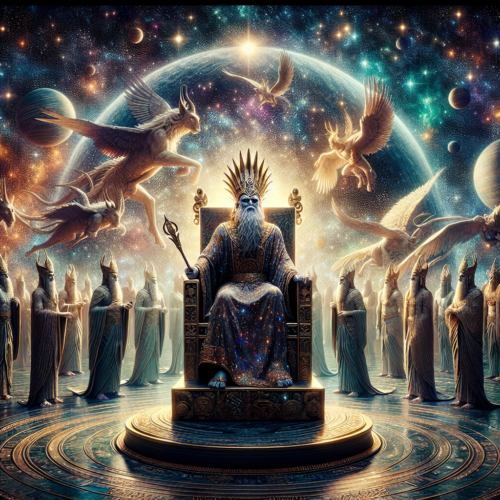Anu, also known as An, is a god of paramount significance in ancient Mesopotamian mythology. He is revered as the divine personification of the sky and the king of the pantheon. His origins trace back to the Sumerian culture, where he was first referenced in writing during the Early Dynastic period around 2375 BCE.
Anu’s lineage is illustrious, being the son of Anshar and Kishar, who represent heaven and earth. His divine consort varied over time and cultures: Urash, Ki, and Nammu are some of the consorts that we know of. Both Enki and Enlil are his sons, and together with Anu, they form the highest divine order of Mesopotamia. Anu used to be the leader of the pantheon, but this is a title that he later bestows on either Enki or Enlil (sources differ on this matter).
Anu’s court
In the celestial court of Anu, the setting is both awe-inspiring and solemn. High above the earthly realm, amidst the boundless expanse of the shimmering heavens, Anu sits majestically on a grand throne crafted from lapis lazuli and gold. His throne is positioned on a raised dais surrounded by swirling clouds of stardust and cosmic lights, reflecting his connection to the sky and the universe.
Anu is draped in robes that shimmer with the colors of the twilight sky: deep blues, purples, and the occasional flash of starlight silver. His presence is commanding, with a horned crown resting upon his head, symbolizing his supreme authority and divine kingship. In this court, Anu functions as the ultimate judge, his decisions shaping the fate of gods and humans alike. He listens intently to the disputes brought before him, his deep, resonant voice filling the chamber as he delivers judgments that are both fair and irrevocable.

Appearances in modern culture
Books and other literature
- “The Epic of Gilgamesh“: Anu appears in this ancient Mesopotamian poem, which is one of the earliest known works of literary fiction.
- “Myths from Mesopotamia: Creation, the Flood, Gilgamesh, and Others” by Stephanie Dalley: This book is a compilation of English translations of the major myths from the region, including references to Anu.
- “The Sumerians: Their History, Culture, and Character” by Samuel Noah Kramer: Kramer’s work discusses the Sumerian civilization and includes information on their deities, including Anu.
- “Inanna, Queen of Heaven and Earth: Her Stories and Hymns from Sumer” by Diane Wolkstein and Samuel Noah Kramer: This collection of translated texts includes references to Anu in the context of Inanna’s mythology.
- “Gods, Demons and Symbols of Ancient Mesopotamia: An Illustrated Dictionary” by Jeremy Black and Anthony Green: This dictionary provides details on Anu and other deities, symbols, and concepts from Mesopotamian beliefs.
